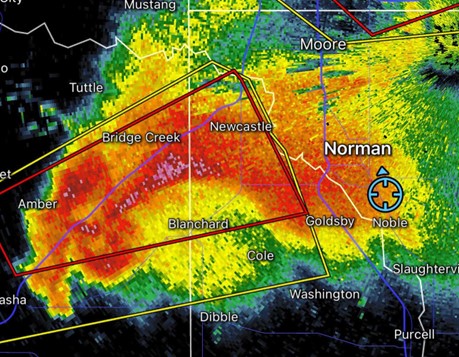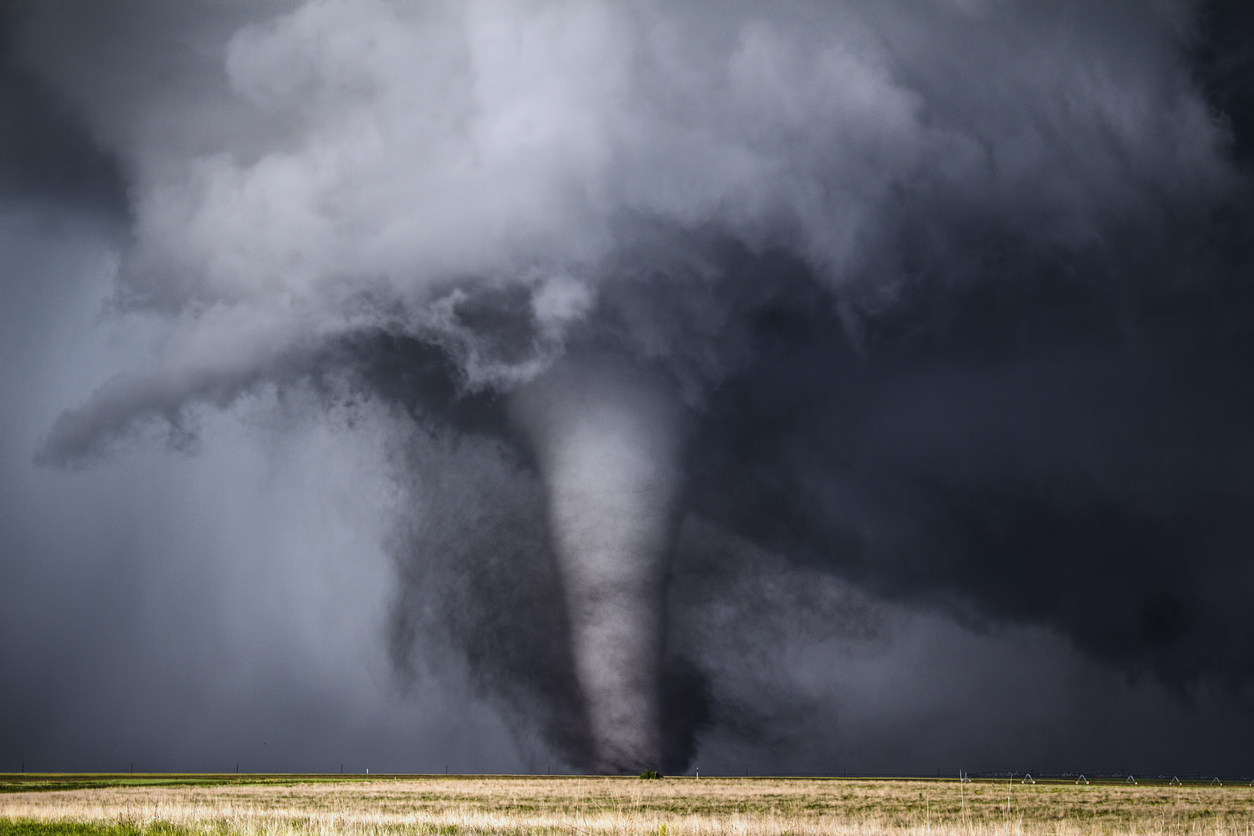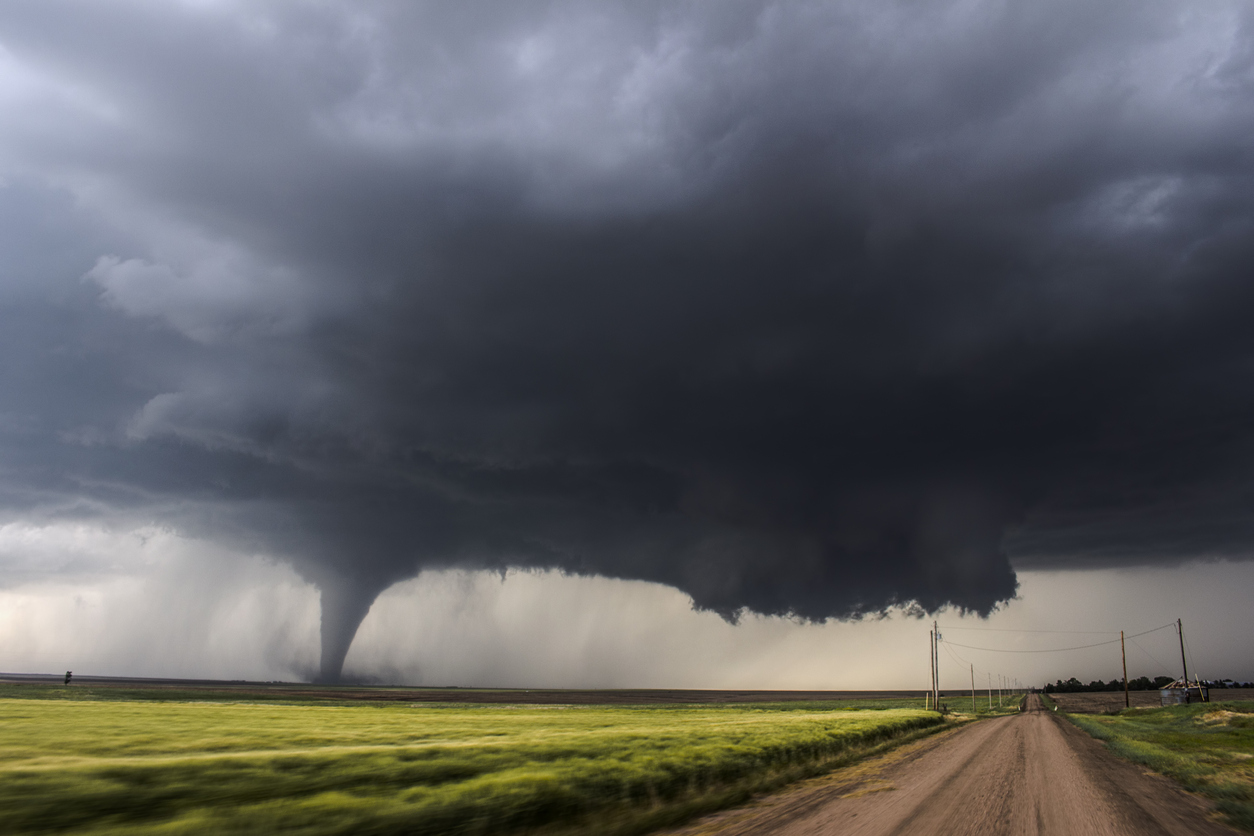Recently the new movie “Twisters,” the sequel to the 1996 classic, was being filmed in downtown Oklahoma City – including some scenes right outside the entrance of our Oklahoma office on North Robinson Avenue! In the original movie, a team of scientists risk their lives chasing down an F5 tornado in order to launch an experimental new device for studying and predicting these deadly weather events.
Tornadoes are a topic of urgent concern for people in Oklahoma. Most recently, on April 19, 2023, a series of deadly tornadoes swept through the state, causing significant damage and loss of life. However, one particular aspect of these storms that gained attention from meteorologists and weather enthusiasts was the potential involvement of the Fujiwhara effect.
What is the Fujiwhara effect?
The Fujiwhara effect is a phenomenon in which two nearby cyclonic storms – such as tornadoes or hurricanes – rotate around a common center of circulation. This effect can cause the storms to merge, resulting in a more significant and potentially more dangerous storm.
This phenomenon was first observed by Sakuhei Fujiwhara, a Japanese meteorologist, in 1921. When the two storms are close enough, their circulation patterns can interact, causing them to rotate around a shared point, almost like a dance.
What happens during the Fujiwhara effect?
When two tornadoes come into contact in this way, the results can vary dramatically, depending on the strength and proximity of the two storms. Sometimes the storms will merge, resulting in a larger and more powerful storm. In other cases, they will repel each other, causing them to move apart and potentially weaken. It’s a rare and fascinating phenomenon that can have significant impacts on weather patterns and storm behavior.
One example involving hurricanes occurred in September 2017 when Hurricane Irma and Hurricane Jose underwent the Fujiwhara effect in the Atlantic Ocean. The two storms began to interact with each other, causing Hurricane Jose to weaken while Hurricane Irma continued on its destructive path, ultimately impacting Florida. Overall, Hurricane Irma caused over $77 billion in damage across the affected regions (approximately $50 billion attributable to damages in Florida), making it one of the costliest hurricanes on record.
Can a tornado and a hurricane merge?
Tornadoes and hurricanes typically don’t merge, but hurricanes and other tropical storms can produce tornadoes as they head inland. For instance, Hurricanes Harvey and Irma caused increased tornado activity throughout Florida and Texas. In the aftermath of Irma, Brevard, Seminole, Volusia and Orange counties in central Florida all experienced concurrent tornado warnings.
Why Oklahoma gets so many tornadoes
Oklahoma sits right in the middle of Tornado Alley, the Central Plains region stretching from Texas to South Dakota that sees extensive tornado activity each year from about March through June. This area is particularly prone to tornadoes because it sits at the intersection of warm, moist, slow-moving air headed north from the Gulf of Mexico and cool, dry, fast-moving air above it headed east from over the Rocky Mountains.
Because of all these tornadoes, the Fujiwhara Effect has been a special focus of research and concern in Oklahoma. Researchers at the Oklahoma University College Campus in Norman were particularly affected by this phenomenon when several severe storms caused significant tornado damage to the campus and surrounding areas back in April.

Did a Fujiwhara effect tornado hit Norman, OK in 2023?
Meteorologists speculated that the Fujiwhara effect may have played a role. Two areas of low pressure had formed over the Southern Plains, one located over western Oklahoma and the other over north-central Texas. Initially, it appeared that these two systems were separate and would not interact. However, as the day progressed, they began moving closer together, with some models suggesting that they could interact and produce a more significant weather event.
Ultimately, it’s difficult to say for certain whether the Fujiwhara effect played a role in the tornado outbreak that occurred on April 19, 2023. Regardless of the specific meteorological factors at play, those storms served as a stark reminder of the destructive power of severe weather. It’s important for communities in tornado-prone areas like Oklahoma to be prepared and take steps to minimize the risks associated with these storms, such as having a plan in place for seeking shelter and staying informed of weather updates. Following local storm trackers like KOCO Channel 5’s very own Derik Kline, who also happens to be the owner and founder of Hailtrace, isn’t a bad idea either.
When tornadoes hit, let Merlin Law Group be your advocate
No matter what the damage, when you’re rebuilding after a tornado, the last thing you want is to fight with your insurance company over your coverage. For people throughout Oklahoma and all over the country who’ve suffered from bad faith dealings from their insurance carriers, Merlin Law Group is their steadfast advocate. For over 30 years, our attorneys have been working to get you what you’re owed. Contact us today if you have questions about a property insurance claim dispute and you want someone on your side.




